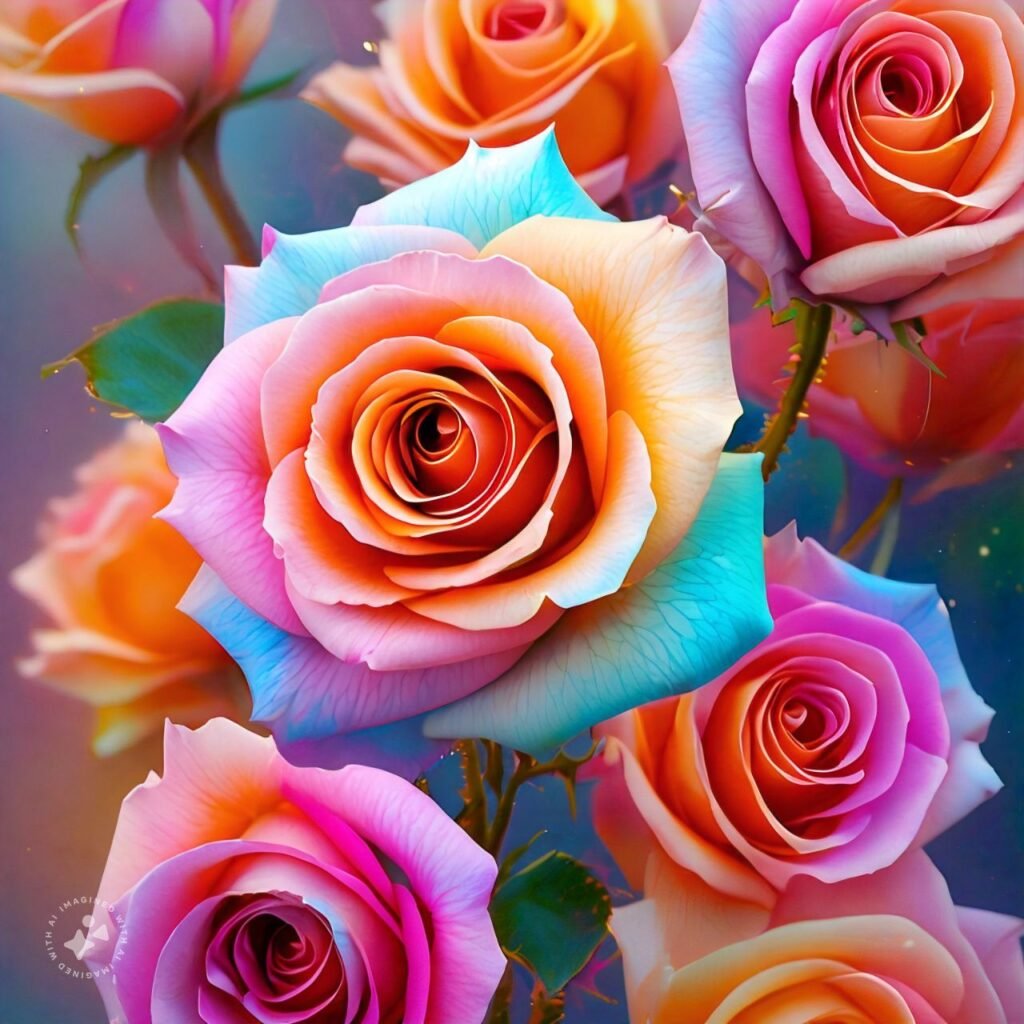
1.Roses, known scientifically as Rosa, are among the most popular and enduring symbols of beauty and love in the plant kingdom. Their vibrant blooms and intoxicating fragrance have captivated gardeners, poets, and lovers for centuries, making them a staple in gardens, bouquets, and art. This post will explore the rich history, diverse types, and the many ways roses continue to influence our lives.
2. The History of Roses
The history of roses dates back thousands of years, with their origins tracing to ancient civilizations in Asia and the Middle East. The earliest fossil records suggest that roses have been around for at least 35 million years. Roses were cultivated in the gardens of Chinese emperors as early as 500 B.C., and the flower also played a significant role in Roman culture, where it was used in celebrations, as confetti, and even in medicinal practices. Over the centuries, roses spread across Europe and later to the Americas, becoming a global symbol of beauty and romance.
3. Types of Roses
Roses come in a wide variety of types, each with its unique characteristics, colors, and growth habits. The most common categories include:
Hybrid Tea Roses: Known for their large, single blooms on long stems, these are the classic florist roses.
Floribunda Roses: These roses are known for their clusters of small blooms, making them ideal for adding color to gardens.
Grandiflora Roses: A cross between Hybrid Tea and Floribunda, these roses combine the best of both worlds, with large blooms and abundant clusters.
Climbing Roses: These roses have long canes that can be trained to grow on trellises or walls, creating stunning vertical displays.
Shrub Roses: Hardy and low-maintenance, these roses are perfect for informal gardens and landscaping.

Each type has its own growing requirements and characteristics, allowing gardeners to choose the perfect rose for their needs.
4. The Anatomy of a Rose
Understanding the anatomy of a rose is key to appreciating its intricate beauty and structure. A rose consists of several parts:

Petals: The colorful, fragrant parts of the flower that attract pollinators.
Sepals: The green, leaf-like structures that enclose and protect the flower bud before it opens.
Stamen and Pistil: The male and female reproductive parts of the flower, essential for pollination.
Thorns (or Prickles): Sharp structures along the stem, which are actually modified epidermal cells, often mistaken for thorns, that protect the plant from herbivores.
This combination of parts makes the rose not only visually stunning but also a marvel of natural engineering.
5. Growing and Caring for Roses
Growing roses requires specific care and attention, but the effort is well worth the reward of vibrant blooms. Here are some essential tips for successful rose gardening:
Location: Choose a sunny spot with at least six hours of direct sunlight per day.
Soil: Well-drained, fertile soil with a pH between 6.0 and 7.0 is ideal.
Watering: Roses need regular watering, particularly during dry spells. Water deeply at the base of the plant to avoid wetting the foliage.
Pruning: Regular pruning helps maintain the shape of the plant, encourages new growth, and removes dead or diseased wood.
Fertilizing: Feed roses with a balanced fertilizer throughout the growing season to promote healthy growth and abundant blooms.

With proper care, roses can thrive in almost any garden, providing years of beauty and enjoyment.

6. Common Rose Diseases and Pests
Like all plants, roses are susceptible to certain diseases and pests that can affect their health and appearance. Some common issues include:
- Black Spot: A fungal disease that causes black spots on the leaves, leading to yellowing and premature leaf drop.
- Powdery Mildew: A white, powdery fungus that appears on leaves, stems, and buds, stunting growth.
- Aphids: Small, sap-sucking insects that can weaken plants and spread diseases.
- Japanese Beetles: Voracious eaters that can skeletonize leaves, devouring the plant in a short time.
Preventive care, such as proper spacing, regular inspection, and using disease-resistant varieties, can help keep these problems at bay. Organic and chemical treatments are also available for more severe infestations.
7. The Symbolism and Meaning of Roses
Roses have held symbolic meanings across different cultures, often representing love, beauty, and even secrecy. The red rose, in particular, is synonymous with romantic love, while white roses are associated with purity and innocence. In ancient times, roses were used as symbols of confidentiality—the Latin phrase “sub rosa” (under the rose) refers to something spoken in secret. Today, roses are also used to convey messages in various social and cultural contexts, from expressing sympathy to celebrating achievements.

8. The Use of Roses in Perfume and Cosmetics
Roses have long been valued in the perfume and cosmetics industry for their captivating fragrance and skin-enhancing properties. Rose oil, extracted from the petals, is a key ingredient in many high-end perfumes, known for its rich, floral scent. Rose water, a byproduct of rose oil production, is widely used in skincare products for its hydrating and soothing effects. The antioxidant properties of roses also make them a popular ingredient in anti-aging and rejuvenating treatments.

9. Roses in Literature and Art
Roses have inspired countless works of literature and art, symbolizing everything from passion to purity. In literature, they have been used as metaphors for beauty, love, and the fleeting nature of life. Shakespeare famously wrote, “A rose by any other name would smell as sweet,” highlighting the intrinsic value of the rose regardless of its label. In visual art, roses have been depicted in paintings, sculptures, and designs, often as central elements in compositions that evoke emotion and meaning.
10. Conclusion: The Enduring Appeal of Roses
Whether in gardens, bouquets, or art, roses continue to captivate the human heart with their timeless beauty and symbolism. Their rich history, diverse types, and profound cultural significance make them one of the most cherished flowers in the world. As we cultivate and care for roses, we carry on a tradition that has been celebrated for millennia, ensuring that these beautiful blooms will continue to inspire and delight for generations to come.
1. How often should I water my roses?
Water roses deeply once or twice a week, ensuring the soil is moist but not waterlogged. In hot weather, increase watering frequency. Water early in the day to prevent disease and focus on the base to avoid wetting the leaves.

2. What is the best fertilizer for roses?
Use a balanced, slow-release fertilizer with equal parts nitrogen, phosphorus, and potassium (e.g., 10-10-10). Apply in early spring, after the first bloom, and again in mid-summer to promote healthy growth and abundant flowering.

3. How do I prune roses?
Prune roses in late winter or early spring before new growth begins. Remove dead, damaged, or weak wood, cutting just above outward-facing buds. Aim to open up the center of the plant for better air circulation and sunlight penetration.
4. When is the best time to plant roses?
Plant roses in early spring or fall, when the weather is cool and the soil is workable. Avoid planting during extreme heat or frost to ensure the roots establish well before growing season.
5. How do I prevent black spot on roses?
Prevent black spot by providing good air circulation, watering at the base, and avoiding wet leaves. Remove and discard affected foliage, and apply a fungicide if needed. Choose resistant varieties to minimize the risk.
6. Can roses grow in containers?
Yes, roses can thrive in containers. Choose a large pot with good drainage, use quality potting mix, and water regularly. Ensure the container receives at least six hours of sunlight daily and fertilize frequently to support growth.
7. What soil is best for roses?
Roses prefer well-drained, loamy soil with a pH between 6.0 and 7.0. Amend heavy clay or sandy soils with organic matter like compost or well-rotted manure to improve fertility and drainage.
8. How do I protect roses from pests?
Protect roses from pests by regularly inspecting for aphids, spider mites, and beetles. Use insecticidal soap, neem oil, or introduce beneficial insects like ladybugs. Maintain plant health through proper watering, fertilization, and pruning.
9. How much sunlight do roses need?
Roses need at least six hours of direct sunlight daily to thrive. Morning sunlight is ideal to dry leaves early and reduce disease risk. Some shade-tolerant varieties can tolerate partial shade but may produce fewer blooms.
10. Why are my rose leaves turning yellow?
Yellow leaves on roses may indicate overwatering, nutrient deficiencies, or disease. Ensure proper watering, provide balanced fertilization, and check for pests or black spot. Prune affected leaves to prevent spread.
11. How do I deadhead roses?
Deadhead roses by cutting spent blooms just above the first set of healthy, outward-facing leaves. This encourages further blooming, maintains plant shape, and prevents energy from being spent on seed production.
12. Can I grow roses indoors?
Yes, certain compact rose varieties can be grown indoors. Place them in a sunny window with at least six hours of light, maintain consistent moisture, and provide humidity. Indoor roses may require supplemental grow lights.
13. What are the best companion plants for roses?
Good companion plants for roses include lavender, garlic, marigolds, and catmint. These plants help deter pests, attract beneficial insects, and enhance garden aesthetics. Avoid planting near aggressive root competitors.
14. How do I prepare roses for winter?
Prepare roses for winter by stopping fertilization in late summer, mulching the base with 4-6 inches of organic material, and covering the crown with soil or straw. In colder climates, consider using a rose cone or burlap wrap.
15. How long do roses take to bloom?
Roses typically take 6-8 weeks to bloom after planting or pruning, depending on the variety and growing conditions. Regular feeding and care will encourage more frequent blooming throughout the season.
16. How can I improve rose fragrance?
Improve rose fragrance by choosing highly fragrant varieties, providing optimal growing conditions, and ensuring plants are healthy. Stress from poor soil, lack of water, or disease can reduce the intensity of rose fragrance.
17. Why aren’t my roses blooming?
Roses may not bloom due to insufficient sunlight, improper pruning, over-fertilization, or pest issues. Ensure your roses receive full sun, prune correctly, and feed with a balanced fertilizer. Check for pests or diseases that may hinder blooming.
18. How do I transplant roses?
Transplant roses in early spring or fall. Dig a wide, deep hole and gently lift the rose with its root ball. Replant at the same depth in a prepared hole, water well, and mulch to retain moisture.
19. What is the best way to water roses?
Water roses deeply and infrequently, focusing on the soil around the base. Avoid overhead watering to reduce disease risk. Early morning watering is best to allow foliage to dry quickly.
20. How do I fertilize roses naturally?
Fertilize roses naturally using compost, well-rotted manure, or organic fertilizers like bone meal and fish emulsion. These enrich the soil and provide essential nutrients for healthy growth and vibrant blooms.
21. Can roses grow in shade?
Most roses prefer full sun but some varieties, like certain climbers and old garden roses, can tolerate partial shade. Expect fewer blooms in shadier conditions, and ensure good air circulation to prevent disease.
22. How do I mulch roses?
Mulch roses with 2-3 inches of organic material, such as compost, bark, or straw. Mulching conserves moisture, suppresses weeds, and regulates soil temperature. Keep mulch away from the base to prevent rot.
23. Why do my rose buds die before opening?
Rose buds may die before opening due to botrytis blight, poor weather conditions, or pest damage. Improve air circulation, avoid overhead watering, and remove affected buds to prevent the spread of disease.
24. Can I propagate roses from cuttings?
Yes, you can propagate roses from cuttings. Take a healthy stem cutting in late spring or early summer, dip it in rooting hormone, and plant it in a well-draining potting mix. Keep it moist and warm until roots develop.
25. What causes black spots on rose leaves?
Black spots on rose leaves are caused by a fungal disease called black spot. It thrives in wet conditions. Prevent it by avoiding overhead watering, ensuring good air circulation, and using fungicides if needed.
26. How do I treat powdery mildew on roses?
Treat powdery mildew on roses by pruning affected areas, improving air circulation, and applying fungicidal sprays. Homemade remedies like a mixture of baking soda, water, and a drop of dish soap can also be effective.
27. Why are my rose stems turning black?
Black stems on roses could indicate cane blight, fungal infection, or winter damage. Prune out affected areas to healthy wood, improve air circulation, and avoid overwatering. Apply fungicide if the problem persists.
28. Can roses survive winter in pots?
Roses can survive winter in pots if they are protected from extreme cold. Move the pots to a sheltered location, insulate with bubble wrap or burlap, and reduce watering. Consider moving them indoors or to a greenhouse in very cold climates.
29. How do I choose the right rose variety for my garden?
Choose a rose variety based on your climate, garden space, and personal preference for color, fragrance, and bloom type. Consider disease resistance, growth habit, and maintenance needs when selecting a variety.
30. What is the best way to control aphids on roses?
Control aphids on roses by spraying with a strong stream of water, using insecticidal soap, or introducing natural predators like ladybugs. Regularly inspect plants and remove any infested leaves to prevent the spread.
